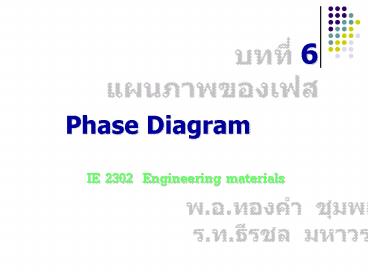Phase Diagram - PowerPoint PPT Presentation
1 / 26
Title:
Phase Diagram
Description:
All compositions above the liquidus line are liquid, and those below the solidus line are solid. ... solidus. alloy 1. alloy 2. Intermetallic Compounds ... – PowerPoint PPT presentation
Number of Views:680
Avg rating:3.0/5.0
Title: Phase Diagram
1
????? 6????????????
Phase Diagram
IE 2302 Engineering materials
?.?.????? ????? ?.?.?????
???????
2
Grain Boundaries
- Grain boundaries are defects which have higher
energy than the grains and are more active with
chemicals. - Help to stop the dislocation.
3
Macroscopic Defects
- Holes, bubbles, surface imperfections, cracks,
and macroscopic impurities
4
??????????????????????????????-??????????????
5
??????????????????????????????-???????????????????
??????
6
phase
- A phase is a state of matter that is distinct in
some way from the matter around it. - Eg. A mixture of ice and water 2 phases
- The distinction between single- and multiple
phase alloys is important to the strength,
corrosion, biocompatibility, and other alloy
properties.
7
Phase Diagram
- Phase of a family of alloys of a general metal
composition are defined by the Temperature-Composi
tion (Phase) diagram for that family of alloys.
8
Cooling Curves
Cooling Curves
- Pure Metals
- Alloys
- Pure Metals
- Alloys
9
Cooling Curves and Phase Diagram
10
Hume-Rothery Rules for Alloying
- The lattice parameters of the two metals must be
similar. - Same type of crystal lattice (FCC,..etc)
- The relative size of the atoms must not exceed
15-20. - (gt15 ? multiple phases)
- Large differences in valence state preclude
solubility. - The chemical affinity of the atoms should be
similar. - A high degree of chemical affinity ? form an
intermetallic compound on solidification
11
Classification of Alloy Systems
1. Solid Solutions 2. Intermetallic Compound 3.
Eutectic Alloy
12
Solid solutions
- Two metals are completely miscible in the liquid
state, and they remain completely mixed on
solidification. - L ? S
- A single -phase system
- Always have a range of possible compositions
- e.g. the solid phase in the copper-gold (Cu-Au)
system has a wide range of compositions between
100 Cu and 100 Au
13
Phase Diagram of a Solid Solution
Phase Diagram of a Solid Solution
- All compositions above the liquidus line are
liquid, and those below the solidus line are
solid. - Solid and liquid exist in the area between both
line. - The solid has only one phase.
- All compositions above the liquidus line are
liquid, and those below the solidus line are
solid. - Solid and liquid exist in the area between both
line. - The solid has only one phase.
LIQUID
liquidus
Temperature
solidus
SOLID
Metal A (100)
Metal B (100)
composition
14
Intermetallic Compounds
- The resulting phase has a fixed chemical
composition or a narrow range of compositions. - e.g. in an amalgam alloy,
- 73.2 Ag and 26.8 Sn ? Ag3Sn (one phase)
- Silver and tin atoms occupying definite positions
in the space lattice.
15
Phase Diagram of an Intermetallic Compound
Ag3Sn, 73.2 Ag and 26.8 Sn
16
Eutectic Alloys
- The metals are soluble in the liquid state, but
separate into two phases in the solid state. - L ? S1 S2 ( 2 solid solutions)
17
Phase Diagram of a Eutectic Alloy
Silver-copper system
- L ? a-solid solution b-solid solution
- The lowest temperature at which any alloy
composition is entirely liquid Eutectic Temp
(779.4C, E) - The eutectic temperature is lower than the fusion
temperature of either Ag and Cu. - At eutectic point, there is no solidification
range. (pure metal) - At eutectic composition (72Ag 28 Cu), the two
phases often precipitate as very fine layers of
one phase over the other one.
18
Silver-copper system
Silver-copper system
19
Ex. Lead-Tin Alloy
Eutectic composition
High tin content
b eutectic
20
How to read a simple phase diagram?
(1) Composition of Liquid and Solid Phases at
Various Temp. (2) Amount of Liquid and Solid
Phases at Various Temp.
21
Composition of Liquid and Solid Phases at Various
Temp.
Alloy (80A 20B)
22
Amount of Liquid and Solid Phases at Various Temp.
- The relative amounts of the two phases in the
liquid-solid region can be determined at a given
temperature by the inverse lever rule. - At 560C for 60A and 40B composition
- Liquid XY/XZ
- Solid YZ/XZ
23
Ex. Silver-Palladium System
24
????????
25
(No Transcript)
26
(No Transcript)






























